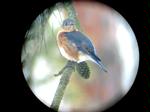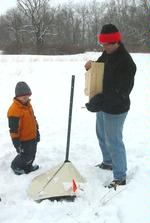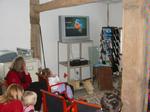News & Events
Notes from the Field Station: Bluebirds
Posted on Wednesday, March 3, 2010
Eastern bluebirds, named Sialia sialis by biologists, have arrived for the season. In the weekend of the international Great Backyard Bird Count, February 12-15, two were spotted in our immediate locale and electronically reported to Cornell University.
Mercer reported 33 bluebirds. And on February 24 at 1:54 p.m. a flock of at least a dozen of these special friends showed their faces and feathers at the bird feeders by our Nature Center. They perched in the trees as if to ask, "Where is my house?" Those houses, or nest boxes, came on Saturday, February 27, when 16 children of the Bear Tree Connections Club showed up with parents at the Field Station on a snowy day to hear an illustrated talk about bluebirds and then trek outside to install 10 new bluebird homes. Those, added to the half dozen or so already in place at the Field Station, will be monitored over the next months by these children, their parents and college students.
The children are the "landlords" for this science project. The boxes will be systematically checked for nests, eggs, hatchlings and fledglings. The study does not end when, at about 17-19 days, the young fledglings leave the box never to return! Their parents, however, will most likely go back to their box and establish three such broods in the following months. Data will be gathered, shared and reported to the Pennsylvania Bluebird Society, an affiliate of the North American Bluebird Society. College students in the Department of Biology may tag along with the children as observations are made. The data may not be revolutionary, but for children these times of collecting data will be eye-openers to their exploration of nature.
Dr. Kathy Robertson, assistant professor of biology, who originally inspired the building of nest boxes for her Animal Behavior class, will use them to help students learn about site selection for nest building in birds. In doing this, they will appreciate why different species of birds select different sites, and what factors are important in site selection. Bluebirds are excellent models to study competition among birds for nesting sites and how birds might modify their behaviors and/or site choices based on competition.
Bluebirds typically are tolerant to humans opening the boxes and counting their eggs, or even being handled. This will give children and biology students the opportunity to get really close to a wild bird and to watch first hand the development of the chicks.
With all the college and community involvement evident in the bluebird project, we are certain that the quest to understand nature is on the rise among us. Whoever participates will be assured of happiness!
According to Wikipedia, the mythology of the "bluebird of happiness" has deep roots that go back thousands of years. Indigenous cultures around the globe hold beliefs that the bluebird is a symbol of cheerfulness, happiness, prosperity, hearth and home, good health and (let us hope) renewal of springtime that is less than a month away!
Clarence Harms, Director
Field Station
Westminster College
harmsc@westminster.edu



More Stories



